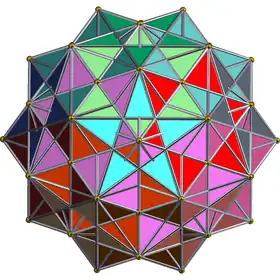| Great 120-cell honeycomb | |
|---|---|
| (No image) | |
| Type | Hyperbolic regular honeycomb |
| Schläfli symbol | {5,5/2,5,3} |
| Coxeter diagram | |
| 4-faces |  {5,5/2,5} {5,5/2,5} |
| Cells | |
| Faces | |
| Face figure | |
| Edge figure | |
| Vertex figure |  {5/2,5,3} {5/2,5,3} |
| Dual | Order-5 icosahedral 120-cell honeycomb |
| Coxeter group | H4, [5,3,3,3] |
| Properties | Regular |
In the geometry of hyperbolic 4-space, the great 120-cell honeycomb is one of four regular star-honeycombs. With Schläfli symbol {5,5/2,5,3}, it has three great 120-cells around each face. It is dual to the order-5 icosahedral 120-cell honeycomb.
It can be seen as a greatening of the 120-cell honeycomb, and is thus analogous to the three-dimensional great dodecahedron {5,5/2} and four-dimensional great 120-cell {5,5/2,5}. It has density 10.
See also
References
- Coxeter, Regular Polytopes, 3rd. ed., Dover Publications, 1973. ISBN 0-486-61480-8. (Tables I and II: Regular polytopes and honeycombs, pp. 294–296)
- Coxeter, The Beauty of Geometry: Twelve Essays, Dover Publications, 1999 ISBN 0-486-40919-8 (Chapter 10: Regular honeycombs in hyperbolic space, Summary tables II,III,IV,V, p212-213)
This article is issued from Wikipedia. The text is licensed under Creative Commons - Attribution - Sharealike. Additional terms may apply for the media files.